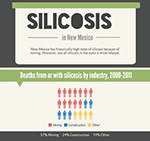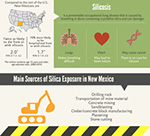Occupational Health Surveillance Program

The New Mexico Department of Health, in partnership with the University of New Mexico School of Medicine, established an occupational injury and illness surveillance system and occupational health registry.
With the collection of occupational health data and physician reports, these data are used target high-risk work place for prevention by education of workers, employers, and health care providers.
Our mission is to promote safe and healthy workplaces for all New Mexico by:
- Evaluating work-related injuries and illnesses.
- Targeting intervention and prevention.
- Raising awareness among workers, employers, health care providers and the public.
Reporting Work-Related Injuries
All healthcare providers, hospitals, clinics are required by law (NMAC 7.4.3) to report work-related injuries or illnesses to the OHSP using the Occupational Health Case Reporting form.
What conditions am I required to report?

- Asbestosis
- Coal workers’ pneumoconiosis
- Hypersensitivity pneumonitis
- Mesothelioma
- Noise induced hearing loss
- Occupational asthma
- Occupational burn hospitalization
- Occupational injury death
- Occupational pesticide poisoning
- Occupational traumatic amputation
- Silicosis
- Other illnesses or injuries related to occupational exposure
How do I report occupational health cases?
- Cases should be reported within 24 hours.
- Download and complete the Occupational Health Case Reporting form.
- Fax form to 505-827-0013; ATTN: NMOHSP
Are there any other ways to report cases?
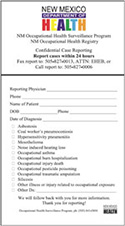
The mini reporting form magnetic notepad (condensed from the full version) is a quick and easy way to remember to fax or call in your reportable cases.
Once we receive your mini report, OHSP will contact your clinic for more detailed information.
Quantities are limited. Available to healthcare providers only.
To order your free notepad, please email doh-eheb@state.nm.us.
Where can I get more information?
Please call 505-827-0006 if you need assistance.
Pesticide Poisoning
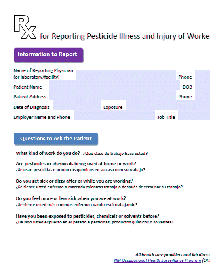
All healthcare providers, hospitals, clinics are required by law (NMAC 7.4.3) to report pesticide poisonings within 24 hours to the OHSP using the Pesticide Illness Reporting form.
How do I report pesticide poisoning?
- Cases should be reported within 24 hours.
- Download and complete the Pesticide Illness Reporting form.
- Fax form to 505-827-0013; ATTN: NMOHSP
Where can I get more information?
Please contact Edward Irobi at 505-476-3530 if you need assistance.
How do I treat patients with pesticide exposure?
The EPA has created a manual that is a quick reference resource for healthcare providers to obtain the best toxicology and treatment information for patients with specific pesticide exposures.
Please visit the Recognition and Management of Pesticide Poisonings website to download the most recent version of the manual.
Adult Lead Poisoning
In New Mexico, industries where lead exposure is common include public safety, radiator repair, mining and construction. However, non-occupational sources of lead exposure are also common in adults and include (but are not limited to) firearm hobbies, retained bullets, and the use of herbal remedies.
Adults should have a blood lead level test if:
- Their employment exposes them to lead.
- They are self-employed or work in small businesses.
- They routinely use leaded products in their hobby.
Please see the Lead in Firing Ranges and Adult Lead Exposure Management Guidelines documents for more helpful information about you can stay safe from Lead Poisoning Prevention in the workplace.
Clinicians Work-Related Health & Safety Resource

Occupational Safety & Health Administration (OSHA) offers a fantastic Work-Related Health & Safety Issues website directed specifically to clinicians.
Physicians, nurses, nurse practitioners, physician assistants, paramedics and other health care professionals often encounter work-related health and safety issues as they care for their patients.
This excellent resource provides information, resources and links to help clinicians navigate the Occupational Safety & Health Administration website and provide care for workers. Topics include evaluating occupational exposures, OSHA requirements for record keeping and medical records, and setting up a safe outpatient office.
Educational Materials
Asthma
Cleaning Products and Work-Related Asthma

Developed in collaboration with the Asthma Control Program.
This two-sided informational brochure explains what asthma and work-related asthma are, cleaning products, workers exposed to cleaners, symptoms, seeing your doctor, and how to practice safe cleaning.
Available in both English and Spanish.
A free mini poster (11”x17”) is available upon request.
Could You Have Work-Related Asthma?
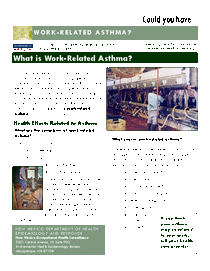
Developed in collaboration with the Asthma Control Program.
This extremely helpful document answers many frequently asked questions about work-related asthma. It explains what work-related asthma is, the health effects related to asthma, what the symptoms are, what causes it, which workers can get it, what you can do if you think you have work-related asthma, and provides a number of helpful website resource links so you can learn more and protect yourself from work-related asthma.
Available in both English and Spanish.
Lead Poisoning
Lead Exposure and Illness in New Mexico Adults Infographic

This infographic is explains about lead exposure and illness in adults and illustrates what the Occupational Health Surveillance Program does including case management services, works with healthcare providers to determine sources of lead, collects data and additional information, and collaborates with OSHA. It also explains how work-related illnesses are tracked.
Available in English only.
Lead in Firing Ranges - How to Reduce Your Exposure
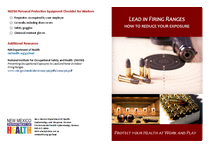
This document was developed in collaboration with the Childhood Lead Poisoning Prevention Program.
This is a personal protective equipment check list for workers explains a few simple steps you can take to reduce your exposure to lead at indoor firing ranges. These steps include wearing a respirator, coveralls including shoe covers, safety goggles, and chemical resistant gloves. It also provides some additional website resource links so you can learn more about preventing occupational exposures to lead and noise at indoor firing ranges.
Available in English only.
Don't Take Home Lead from Your Job!
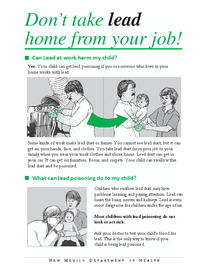
This document answers many questions about workers who are at risk of bringing home lead from work.
Available in English only.
Mesothelioma
Mesothelioma in the Workplace in New Mexico

This infographic is explains about mesothelioma in the workplace in New Mexico and explains that exposure to asbestos fibers is the primary risk factor in developing mesothelioma, provides a list of occupations with risk of asbestos exposure, states the typical timeframe between asbestos exposure and mesothelioma diagnosis, and provides the protocol and decision tree used.
Available in English only.
Fire Ash
Safe Cleanup of Fire Ash
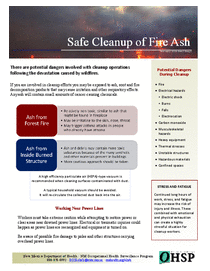
Developed by our friends at the National Institute for Occupational Safety and Health.
There are many potential dangers involved with cleanup operations following the devastation caused by wildfires. If you are involved in cleanup efforts you may be exposed to ash. This fact sheet describes details about the potential dangers which include fire, electrical, carbon monoxide, musculoskeletal hazards, heavy equipment, thermal stresses, unstable structures, hazardous materials, and confined spaced.
Available in English only
Silicosis
Silicosis in New Mexico Infographic
This infographic illustrates that New Mexico has historically high rates of silicosis because of mining. However, not all silicosis in the state is mine-related. It clearly shows the relative comparison of deaths from or with silicosis by industry between mining, construction, or other industries. It goes on to explain that silicosis is a preventable occupational lung disease that is caused by breathing in dusts containing crystalline silica and more.
Available Formats
This infographic is available below in both PDF and JPEG formats as well as in single and multiple page versions.
- Single File
- Multiple Files
Mailing List
Please subscribe to the Occupational Health Surveillance Mailing List to receive quarterly emails about occupational health and issues in New Mexico. You'll be glad you did!
Bulletin
The OHSP bulletin is a periodical that is meant to keep you informed and updated on a variety of occupational health surveillance topics.


